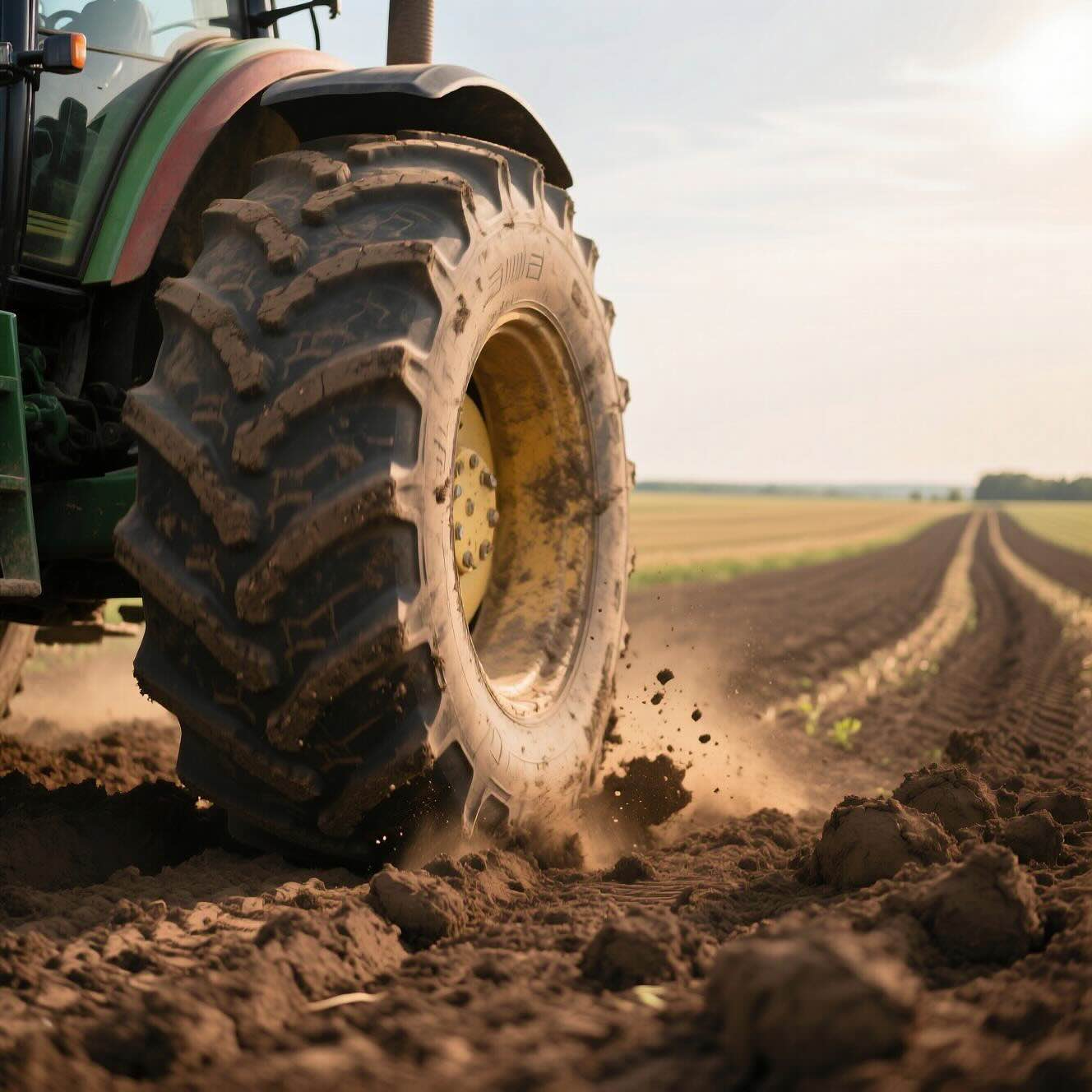
Radial agricultural tires combined with straw cover significantly reduce soil compaction, making them key tools for sustainable soil conservation in mechanized farming.
When we think about farming, we often imagine seeds, sunshine, and harvests. But beneath the surface, there’s another battle going on — the fight to protect soil health from the heavy machinery that modern agriculture depends on. 🚜
As tractors, trucks, and harvesters get bigger and heavier, they put increasing pressure on the soil. This leads to soil compaction, where the ground gets squashed so tightly that water, air, and roots struggle to move. The result? Lower crop yields, weaker plants, and long-term damage to one of our most precious resources — soil.
But here’s the twist: scientists in Brazil have been studying two powerful “allies” in the fight for soil conservation:
Their research asks a fascinating question: Can the right combination of straw cover and tire type reduce soil stress and keep farmlands healthier for the future? Let’s dig into what they found.
Healthy soil is like a living sponge — it holds water, stores carbon, supports billions of microorganisms, and gives plants the space they need to grow. But when soil gets compacted by machines, its structure collapses:
🌊 Water infiltration drops → more runoff, erosion, and flooding.
🌬 Airflow decreases → roots and microbes suffocate.
🌾 Roots can’t grow deep → crops become weaker and less productive.
♻️ Nutrient cycling slows → long-term soil fertility declines.
Soil conservation isn’t just about today’s harvest; it’s about protecting future productivity and sustainability.
The study, led by researchers at several Brazilian universities, used a Static Tire Test Unit (STTU) — basically a machine that presses tires into soil while sensors measure stress, compaction, and resistance.
They tested three tire types:
And they tried them on four surfaces:
The key question: How much does straw help cushion the soil, and which tires are gentlest?
👉 Bigger footprint = less compaction.
👉 Road tires are tough on fields. Agricultural tires are gentler.
Straw acted like a natural mattress for the soil:
That means straw cover absorbs stress, spreads out the load, and keeps the soil looser for roots to grow.
But here’s a catch — many sugarcane mills remove straw for bioenergy (ethanol or electricity). While good for renewable energy, this practice leaves soils vulnerable to compaction. Balancing soil conservation vs. energy use is a big sustainability challenge.
Using simulation models, researchers checked how deep compaction stress goes:
With straw cover, stress still went deep, but intensity was reduced:
👉 Straw helps, but tire choice still matters most.
This study shows that soil conservation in mechanized farming is not just about what you plant, but what you drive. Here are the practical takeaways:
✅ Choose radial tires when possible. They spread pressure better and protect soil structure.
✅ Keep straw on the soil. Even partial coverage reduces compaction and protects roots.
✅ Avoid truck tires in the field. They’re designed for highways, not farmland, and cause deep compaction.
✅ Use controlled traffic farming. Restrict heavy machines to fixed lanes to protect most of the field.
✅ Balance bioenergy and soil needs. Removing too much straw for ethanol might cost soil fertility and yield in the long run.
This research opens doors for innovation in agricultural engineering:
The big picture? Protecting soil means protecting future harvests, farmer livelihoods, and global food security.
Soil is more than dirt under our feet — it’s the foundation of life. 🌍 This Brazilian study shows us that something as simple as the right tire and a blanket of straw can make a huge difference in soil conservation.
By combining better machinery choices with smart soil management, we can build farming systems that are productive, sustainable, and resilient. After all, once soil is damaged, it can take decades (or longer) to recover — but with the right practices, we can keep it healthy for generations. 🌱💚
🌾 Straw Cover - Leftover crop residue (like sugarcane stalks or wheat straw) spread over the soil after harvest — it acts as a blanket that protects soil from erosion, water loss, and compaction.
🛞 Radial Tire - A modern tire where the internal layers run straight across the tire (radially). It’s flexible, spreads weight better, and is gentler on soil.
🛞 Bias-Ply Tire - An older tire design where layers crisscross diagonally. Strong and cheap, but it presses harder on soil and causes more compaction.
🚛 Truck (Road) Tire - Tires made for highways and cargo trucks — durable on pavement but harsh on soil, since they focus weight in smaller contact areas.
📉 Soil Compaction - When soil particles are pressed tightly together by heavy machinery, reducing the spaces for air, water, and roots. Bad news for crops!
📏 Soil Penetration Resistance (SPR) - A measure of how hard it is for roots (or a probe) to push through soil. Higher SPR = tougher soil for plants to grow in.
🌍 Soil Stress - The pressure or force applied to the soil by machinery wheels — like footprints in sand, but deeper and more lasting.
👣 Contact Area - The “footprint” of a tire on the soil — bigger footprints spread the weight, smaller ones concentrate pressure.
💡 Soil Conservation - All the methods farmers use to protect soil health, fertility, and structure so it can keep producing food sustainably.
Source: Marques Filho, A.C.; Santana, L.S.; Martins, M.B.; Guimarães Júnnyor, W.d.S.; Medeiros, S.D.S.d.; Lanças, K.P. Straw Cover and Tire Model Effect on Soil Stress. AgriEngineering 2025, 7, 263. https://doi.org/10.3390/agriengineering7080263
From: Federal University of Lavras (UFLA); Federal University of Jequitinhonha and Mucuri Valleys (UFVJM); Mato Grosso do Sul State University (UEMS); Santa Catarina Federal University—UFSC; São Paulo State University—UNESP.